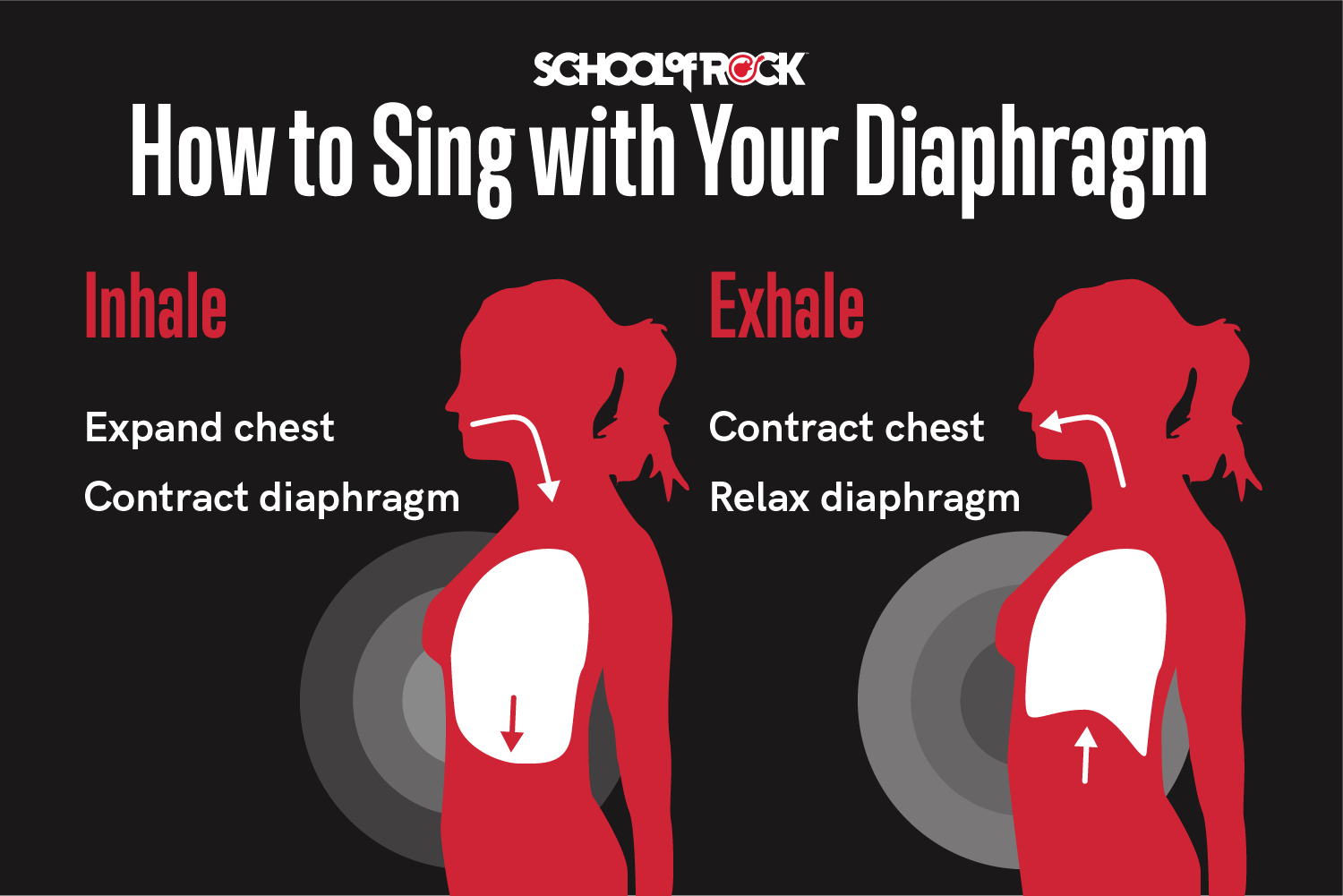Professional singers know how physically demanding singing can be. It takes a lot of stamina and energy to sing onstage and bring the venue to life. That’s why singing, like any other physical activity, should involve a warm-up, as well as a vocal cool-down. At School of Rock, we make these vocal warm-ups a ritual, whether it’s to prepare for a singing lesson or a show rehearsal. These quick vocal exercises can be done in just 10 to 20 minutes, and they should become an integral part of any successful practice routine.
Why do you need to warm up your voice?
We warm up our voices so we can keep them healthy, sound our best and protect against damage. Vocal warm-ups are especially important for expanding your vocal range, improving breath control, and ensuring vocal health. Voice training requires dedication, and warming up before each performance is a must for any serious singer.
9 best vocal warm-ups for singers
There are many simple vocal exercises you can use to warm up your voice, so you have a lot of options when it comes to deciding how to warm up your voice. Fortunately, School of Rock can help you narrow them down. Here are nine of the best vocal warm-ups used by our vocal instructors.

1. Yawn-sigh Technique
For this quick vocal exercise, simply yawn (take in air) with your mouth closed. Then, exhale through your nose as if you are sighing. This will help relax your voice and improve its range.
Why this works: It relaxes the larynx and improves vocal flexibility, helping singers achieve a smoother tone.
Level: Perfect for beginners and experienced singers alike.
2. Humming warm-upS
Humming is one of the best vocal warm-ups because it doesn’t put a lot of strain on your vocal cords. Place the tip of your tongue behind your bottom front teeth and hum up and down the major scale while keeping your mouth closed. Each note should sound like “hmmm” — including the “h” sound is less taxing on your voice.
Why this works: It gently engages your vocal cords without causing strain, promoting a clear and resonant tone.
Level: Ideal for singers at any skill level.
3. Vocal Straw Exercise
To perform the vocal straw exercise (also known as straw phonation), take a straw and hum through it. Start at the bottom of your range and slide up to the top slowly and evenly. Then, hum your favorite song through the straw. You can also place the straw in a partially full glass of liquid and blow controlled bubbles in the glass.
Why this works: It reduces vocal tension, improves breath control, and helps maintain vocal health.
Level: Great for singers who want to refine breath control and pitch.
4. Lip buzz Vocal warm-up
As far as vocal warm-ups go, lip buzz (or lip trill, as it is sometimes called) is very simple. The goal is to make a motorboat sound by making your lips vibrate as you blow air through your mouth and nose. You can incorporate pitch slides as well.
Why this works: It gently warms up your vocal cords and improves coordination.
Level: Suitable for all levels, especially beginners.
5. Tongue trill exercise
The tongue trill vocal exercise is difficult for some singers. It involves curling your tongue and rolling your R’s as you go through your range from low to high.
Why this works: It increases airflow and strengthens control over pitch changes.
Level: Best for intermediate to advanced singers.
6. Jaw Loosening ExerciseS
When singing, you want to drop your jaw lower than when you are just talking. With your finger, trace back along your jawline from your chin to your ear. That curved space between your jaw and your ear is where you want to drop your jaw.
Pretend you are yawning with your mouth closed and feel where your jaw drops. Avoid just dropping your chin.
Why this works: It releases tension in the jaw, enabling a more open and resonant sound.
Level: Beneficial for singers of all levels.
7. Two-octave pitch glide Warm-Up
For this easy vocal warm-up, make an “eeee” or “ohhhh” sound and gradually glide through the chromatic notes of a two-octave range. Glide up and then back down. This will transition from your chest voice to your head voice.
Why this works: It smooths the transition between vocal registers and expands range.
Level: Great for singers aiming to bridge vocal breaks.
8. Vocal Sirens Exercise
Much like the pitch glide, the siren exercise takes an “oooo” sound and gradually goes from the lowest note of your range to the highest and back down, like a siren for an emergency vehicle. The sound is continuous and covers the tones between the notes.
Why this works: It engages the full range and improves control over dynamics.
Level: Suitable for singers of all levels.
9. Vocal Slides Technique
This technique is also known as a portamento, which is Italian for “the act of carrying.” Much like the siren exercise, you slide from one note to the next in your range, but you don’t sing the in-between notes.
Why this works: It builds smooth transitions between notes and improves tone consistency.
Level: Perfect for singers refining their pitch and tonal quality.
BREATHING TECHNIQUES FOR BETTER SINGING
Now that you've mastered a few vocal warm-ups and exercises, always remember to maintain good posture and use proper breathing techniques. Two common breathing techniques are singing from your diaphragm and exhaling on a hiss. Keep reading to learn how you can perform these to improve your singing. You can also sign-up for a trial singing lesson in-person or online at your nearest School of Rock.
1. Sing from Your Diaphragm
When singing, it is vitally important to use proper breathing techniques to avoid hurting your voice. It is most common to breathe from the chest during everyday activities, including speaking, but singing requires breathing from the diaphragm. Proper breathing gives your voice more power, more control, and a fuller, more expressive tone. Sing from your diaphragm to avoid straining your voice. Your body should be relaxed and balanced, with your weight slightly forward.

The sound of your voice doesn’t actually come from your diaphragm, of course — sound is generated by vibrations of your vocal cords. The vibrations are caused by air being pushed out of your lungs. Your diaphragm is what controls the pushing and is responsible for putting power behind your voice.
2. Exhale on a hiss
A hissing breath exercise is a great way to start when learning how to warm up your voice before singing. This technique forces vocalists to sing from their diaphragms and improves breath control.
To master the exhale on a hiss breathing technique, it’s important to:
- Stand up straight and relax your body. This will also relax your diaphragm and release any tension that could prevent you from singing incorrectly.
- Breathe in through your mouth and count to five. As you breathe, bring the air deep into your lungs. A “singer’s breath” should not make your chest puff out or your shoulders rise — instead, your belly should expand outward.
- Exhale and count to nine. While exhaling, make a hissing noise that sounds like the first letter of the word “sizzle.” By the time you are done counting, all the air should be expelled from your lungs.
Once you build more lung capacity and get comfortable with this exercise, you can breathe in for a seven count and exhale for a 12 count.
Now that you've warmed up your voice and know how to breathe from your diaphragm and exhale on a hiss, you’re ready to sing.
How to cool down your voice after singing
After vocal warm-ups and singing, it is essential that you also cool down your voice. You can use the same vocal exercises you used during your warm-up, starting with the most intense and working down to the least intense. Simply using the humming vocal exercise will also allow your voice to cool down and relax. Following these tips will keep your voice strong and allow you to perform at your best.
Vocal warm-ups are a critical part of any singer’s practice and performance routine. These quick and easy vocal exercises will refine your technique, build your vocal power and control, and help expand your vocal range.
At School of Rock, our trained vocal instructors teach students all aspects of singing, including voice training and other vocal training techniques that thousands of professional singers use every day to keep their voices in shape and sounding their best. Ready to start voice training? Sign up for a singing lesson now, or read more about our performance-based music programs.






